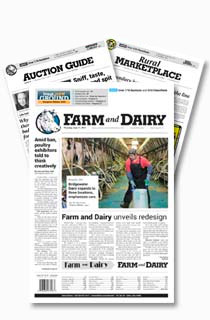
SALEM, Ohio — Eric Stewart feels excited as he walks through the history of rabbits to his desk at the American Rabbit Breeders Association’s International Headquarters and Museum in Knox, Pennsylvania. The ribbons, awards, books, black-and-white photographs and artifacts show the significance of rabbits dating from the Roman Empire to the present.
As executive director, Stewart manages the day-to-day business at ARBA for its members, the board members and the 52 rabbit breeds that ARBA officially recognizes.
“For all 52 breeds, we also have an entire gallery space for all their information,” Stewart said.
ARBA has the largest library of rabbit periodicals and artifacts in the world, according to Stewart. ARBA’s library houses records for all the rabbits and guinea pigs that have entered all past national rabbit conventions, including over 27,000 rabbits that entered the 2023 national convention. ARBA hosts shows monthly, around the world.
The library organizes periodicals from national rabbit clubs, such as the guidebooks and magazines published by the clubs. This includes the American Netherlands Dwarf Rabbit Club magazines since their inception in the 1970s when ARBA officially recognized the breed.
Known as the ARBA Hall of Fame Library And Museum, it was dedicated in 2002, in Bloomington, Illinois, and moved to Clarion County, Pennsylvania, in 2018, and expanded in 2020. The relocation brought the library closer to the region of its highest membership density, Stewart said, and reduced the library’s operating expenses. Nearby, Ohio continues to lead the country in the most rabbit show entries, he noted.
“We are very proud of what we’ve done here at ARBA and the ability to expand,” he said.
Making room for past and present
The annual Open House has expanded, too. June 21 is this year’s annual Open House celebration at ARBA and a new rabbit show brings live bunnies to headquarters with members from all over the country.
“We have been hosting an Open House each year since we opened, and last year was our first time that we had a Challenge Cup, which we are going to have again this year,” Stewart said.
ARBA’s board approved the special rabbit show and its members who enter can bring up to two rabbits to the Challenge Cup. The rabbit show will be outside, and Stewart said the headquarters building itself, located just off Interstate 80, is easily accessible as a former general store, with a layout that allows for a good flow between visitors and the exhibits inside.
“It’s so exciting that we can now not only showcase some of the history that we’ve displayed in the past, but we have the opportunity to find more things that were previously in storage,” he said.
A hidden room was discovered behind a wall in the library. Once sealed and forgotten, the room is now where Ellie Bonde, a library co-chair, does curatorial work with items in storage. Stewart said the space is known as “Ellie’s Room.”
“I am proud to display the oldest color photo book exclusively of rabbits, dated 1821,” Bonde said. “We have on display many items used and owned by long-time members, such as judging coats, briefcases and book covers,” Bonde said.
Stewart emphasized it’s truly the “oldest known publication in the world that deals with just rabbits. Most publications would include other species.”
In her personal life, Bonde began taking care of rabbits when her child asked for a bunny for a birthday present, and they got involved with ARBA shows. Bonde eventually began serving in a national rabbit club and then began to help ARBA organize the library in 1998.
Shaping history
Visitors to the library can learn about rabbit feed throughout history and the types of equipment used to take care of rabbits, from older porcelain crocks up to the modern feeders that are common now. The library’s collection of documents reveals the historical roles that meat rabbits played in the World Wars, and a Purina advertisement shows a child eating a rabbit leg — “Eat more domestic rabbit.”
“A lot of folks don’t realize just the impact that domestic rabbits have had, even nationally,” Stewart said. “Millions of lives were saved during World Wars when they would have to ration, and rabbits were an affordable, quiet, small venture. People could raise protein in their backyards.”
Stewart’s passion for rabbits began in his backyard in 1986 when his parents permitted him to get a rabbit for a 4-H project. It was the only animal he could raise at home since he didn’t have the space for larger animals. He’s been raising rabbits ever since and now has a fiber farm with Angora wool.
“The number one thing that has always stood out to me is probably rabbits are the most underrated species of animal in existence,” Steward said. “Rabbits get no credit for anything. The only adage we ever hear is, ‘Oh, rabbits, they multiply,’ but what people don’t realize is how much rabbits have contributed to modern civilization.”
A lasting legacy
Many of the library’s prints and materials came from the Bob Whitman collection, a former library chairperson, from Texas. The collection includes lithography prints, some of the oldest types of rabbit prints produced in the world, using a printing technique with a flat stone or metal plate to create the images.
“Bob Whitman was a huge collector and when he passed away in 2009, he left all of his collections to the American Rabbit Breeders Association. The following year, I drove down to Texas and picked up the collections and brought them back to ARBA,” Stewart said.
Some of the magazines in the library are over 100 years old. Whitman helped to secure a deal for ARBA to purchase a collection of Fur and Feather magazines from the United Kingdom. Fur and Feather is still in publication and Jason Holder, the current managing editor at Fur and Feather, said the collection of magazines ARBA has in its library is rare.
“This could be one of only a few full-bound sets of Fur and Feather in the world,” Holder said.
Holder is a director of a U.K. printing business operating in a building that’s notable for being continuously in use for printing since around 1770. While books from the 1700s aren’t common in most libraries, Bonde said ARBA’s collection has some periodicals from the 1700s, too.

ARBA’s headquarters welcomes visitors throughout the year, but for a guided tour, Stewart said to call headquarters ahead of time to make arrangements.
When visitors arrive, they’ll see Edna first, a custom replica car in the parking lot modeled on a photograph from the 1930s showing a group of rabbit enthusiasts who decorated their ride for a cross-country road trip to a national rabbit convention. Their rabbits didn’t place very well in the show, but their excitement for rabbits nearly 100 years ago is worthy of recognition.
“This is a very popular photo opportunity location for visitors,” Bonde said.
For more information about the ARBA’s headquarters, visit https://arba.net or call 814-797-4129.












